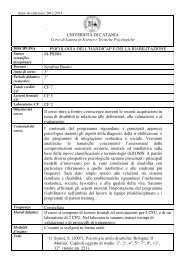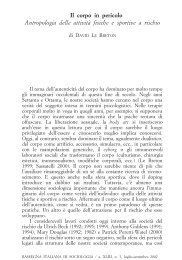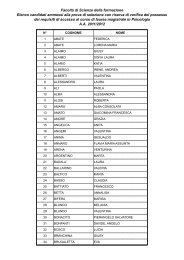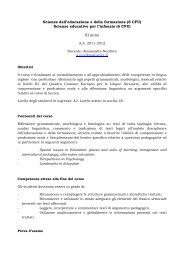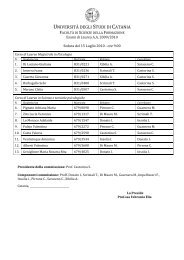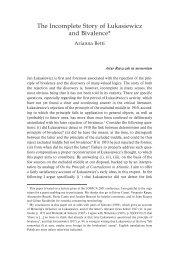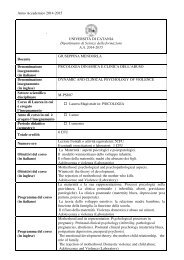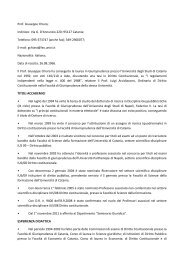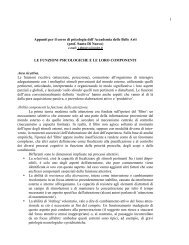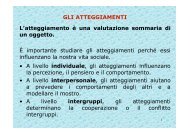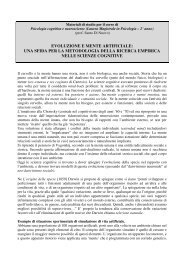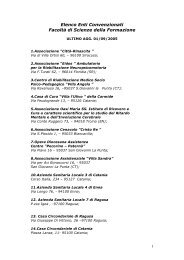Paralisi cerebrali infantili e paraplegie spastiche ereditarie - TESTO
Paralisi cerebrali infantili e paraplegie spastiche ereditarie - TESTO
Paralisi cerebrali infantili e paraplegie spastiche ereditarie - TESTO
You also want an ePaper? Increase the reach of your titles
YUMPU automatically turns print PDFs into web optimized ePapers that Google loves.
09-capitolo 19-07-2006 10:31 Pagina 273<br />
9 – PARALISI CEREBRALI INFANTILI E PARAPLEGIE SPASTICHE EREDITARIE<br />
[108] PATERNOTTE C., RUDNICKI D., FIZAMES C. ET AL., Quality assessment<br />
of whole genome mapping data in the refined familial<br />
spastic paraplegia interval on chromosome 14q. Genome Res.<br />
8:1216-1227, 1998.<br />
[109] PRASAD A.N., BREEN J.C., AMPOLA M.G.ET AL., Argininemia: a<br />
treatable genetic cause of progressive spastic diplegia simulating<br />
cerebral palsy: case reports and literature review. J. Child.<br />
Neurol. 12:301-309, 1997.<br />
[110] RAPHAELSON M.I., STEVENS J.C., ELDERS J. ET AL., Familial<br />
spastic paraplegia, mental retardation and precocious puberty.<br />
Arch. Neurol. 40:809-810, 1983.<br />
[111] RA S K I N D W.H., PE R I C A K- VA N C E M.A., LE N N O N F. E T A L. ,<br />
Familial spastic paraparesis: evaluation of locus heterogeneity,<br />
anticipation, and haplotype mapping of the SPG4 locus on the<br />
short arm of chromosome 2. Am. J. Med. Genet. 74:26-36, 1997.<br />
[112] REFSUM S., SKILLICORN SA., Amyotrophic familial spastic<br />
paraplegia. Neurology 4:40-47, 1954.<br />
[113] REID E. Science in motion: common molecular pathological<br />
themes emerge in the hereditary spastic paraplegias. J. Med.<br />
Genet. 40:81-86, 2003.<br />
[114] REID E., DEARLOVE A.M., OSBORN O. ET AL., A locus for autosomal<br />
dominant “pure” hereditary spastic paraplegia maps to<br />
chromosome 19q13. Am. J. Hum. Genet. 66:728-732, 2000.<br />
[115] REID E., DEARLOVE A.M., RHODES M. ET AL., A new locus for<br />
autosomal dominant “pure” hereditary spastic paraplegia<br />
mapping to chromosome 12q13, and evidence for further genetic<br />
heterogeneity. Am. J. Hum. Genet. 65:757-763, 2000.<br />
[116] REID E., DEARLOVE A.M., WHITEFORD M.L. ET AL., Autosomal<br />
dominant spastic paraplegia: refined SPG8 locus and additional<br />
genetic heterogeneity. Neurology 53:1844-1849, 1999.<br />
[117] REID E., GRAYSON C., RUBINSZTEIN D.C. ET AL., Subclinical<br />
cognitive impairment in autosomal dominant “pure” hereditary<br />
spastic paraplegia. J. Med. Genet. 36:797-798, 1999.<br />
[118] RE S T I V O D.A., MA R C H E S E RA G O N A R., GI U F F R I D A S., FA L S A P E R L A<br />
R. Successful botulinum toxin treatment of dysphagia in a young<br />
child with nemaline myopathy. Dysphagia, 16:228-229, 2001.<br />
[119] RESTIVO D.A., MARCHESE RAGONA R., STAFFIERI A., DE GRAN-<br />
DIS D., Successful botulinum toxin treatment of dysphagia in<br />
oculopharyngeal muscular dystrophy. Gastroenterology,<br />
119:1416, 2000.<br />
[120] ROTHNER A.D., YAHR F., YAHR M.D., Familial spastic paraparesis,<br />
optic atrophy, and dementia. New York State J. Med.<br />
756-758, 1976.<br />
[121] SACK G.H., HUETHER C.A., GARG N., Familial spastic paraplegia<br />
– clinical and pathologic studies in a large kindred. Johns<br />
Hopkins Med. J. 143:117-121, 1978.<br />
[122] SA U G I E R- VE B E R P., MU N N I C H A., BO N N E A U D . E T A L., X-linked spastic<br />
paraplegia and Pelizaeus-Merzbacher disease are allelic disorders<br />
at the proteolipid protein locus. Nat. Genet. 6:257-262, 1994.<br />
[123] SCHWARZ G.A., LIU C.N., Hereditary (familial) spastic paraplegia;<br />
further clinical and pathologic observations. AMA<br />
Arch. Neurol. Psychiatry 75:144-162, 1956.<br />
[124] SERENA M., RIZZUTO N., MORETTO G. ET AL., Familial spastic<br />
paraplegia with peroneal amyotrophy. A family with hypersensitivity<br />
to pyrexia. Ital. J. Neurol. Sci. 11:583-588, 1989.<br />
[125] SERI M., CUSANO R., FORABOSCO P. ET AL., Genetic mapping to<br />
10q23.3-q24.2, in a large Italian pedigree, of a new syndrome<br />
showing bilateral cataracts, gastroesophageal reflux, and spastic<br />
paraparesis with amyotrophy. Am. J. Hum. Genet. 64:586-<br />
593, 1999.<br />
[126] SHEVELL M.I., MAJNEMER A., MORIN I. Etiologic yield of cerebral<br />
palsy: a contemporary case series. Pediatr. Neurol.,<br />
28:352-359, 2003.<br />
[127] SHIBASKI Y., TANAKA H., IWABUCHI K. ET AL., Linkage of autosomal<br />
recessive hereditary spastic paraplegia with mental<br />
impairment and thin corpus callosum top chromosome 15q13-<br />
15. Ann. Neurol. 48:108-112, 2000.<br />
[128] SILVER J.R., Familial spastic paraplegia with amyotrophy of<br />
the hands. Ann. Hum. Genet. 30:69-75, 1996.<br />
[129] SIMPSON M.A., CROSS H., PROUKAKIS C. ET AL., Maspardin is<br />
mutated in mast syndrome, a complicated form of hereditary<br />
spastic paraplegia associated with dementia. Am. J. Hum.<br />
Genet. 73:1147-1156, 2003.<br />
273<br />
[130] STARLING A., ROCCO P., CAMBI F. ET AL., Further evidence for<br />
a fourth gene causing X-linked pure spastic paraplegia. Am. J.<br />
Med. Genet. 111:152-156, 2002.<br />
[131] STEINMULLER R., LANTIGUA-CRUZ A., GARCIA-GARCIA R. ET<br />
AL., Evidence of a third locus in X-linked recessive spastic<br />
paraplegia. Hum. Genet. 100:287-289, 1997.<br />
[132] STEWART R.M., TUNELL G., EHLE A., Familial spastic paraplegia,<br />
peroneal neuropathy, and crural hypopigmentation: a new<br />
neurocutaneous syndrome. Neurology 31:754-757, 1981<br />
[133] STRAUSSBERG R., BLATT I., BRAND N. ET AL. X-linked mental<br />
retardation with bilateral clasped thumbs. Report of another<br />
affected family. Clin. Genet. 40:337-341, 1991.<br />
[134] STRUMPELL A. Die primaere Seitenstrangsklerose spastische<br />
Spinalparalyse. Deutsch Z. Nervenheilk 27:291-339, 1904.<br />
[135] SUTHERLAND J.M., GLASG D., Familial spastic paraplegia. Its<br />
relation to mental and cardiac abnormalities. Lancet ii:179-<br />
180, 1957.<br />
[136] TALLASKEN C.M., DURR A., BRICE A., Recent advances in herediatary<br />
spastic paraplegias. Curr. Opin. Neurol. 14:457-463,<br />
2001.<br />
[137] TALLAKSEN C.M., GUICHART-GOMEZ E., VERPILLAT P. ET AL.,<br />
Subtle cognitive impairment but no dementia in patients with<br />
spastin mutations. Arch. Neurol. 60:1113-1118, 2003.<br />
[138] TAMAGAKI A., SHIMA M., TOMITA R. ET AL., Segregation of a<br />
pure form of spastic paraplegia and NOR insertion into Xq11.2.<br />
Am. J. Med. Genet. 94:5-8, 2000.<br />
[139] THOMAS P.K., MISRA V.P., KING R.H. ET AL., Autosomal recessive<br />
hereditary sensory neuropathy with spastic paraplegia.<br />
Brain 117 (Pt 4):651-659, 1994.<br />
[140] TUCK R.R., O’NEILL B.P., GHARIB H. ET AL., Familial spastic<br />
paraplegia with Kallman’s syndrome. J. Neurol .Neurosurg.<br />
Psych. 46:671-674, 1983.<br />
[141] UYAMA E., TERAMOTO H., HASHIMOTO Y. ET AL., Two siblings<br />
of familial spastic paraplegia with cutis verticis gyrata and<br />
mental retardation. Rinsho Shinkeigaku 28:97-101, 1988.<br />
[142] VALENTE E.M., BRANCATI F., CAPUTO V. ET AL., Novel locus for<br />
autosomal dominant pure hereditary spastic paraplegia<br />
(SPG19) maps to chromosome 9q33-q34. Ann. Neurol. 51:681-<br />
685, 2002.<br />
[143] VAN BOGAERT L., Etude sur la <strong>paraplegie</strong> spasmodique familiale.<br />
La famille Van L: forme classique pure avec atrophie<br />
optique massive chez certaine de ses members. Considerations<br />
genetiques sur la <strong>paraplegie</strong> spasmodique familiale en general.<br />
Acta Neurol. Belg. 52:795-807, 1952.<br />
[144] VAZZA G.Z.M., BOARETTO F., MICAGLIO G.F.ET AL., A new<br />
locus for autosomal recessive spastic paraplegia associated<br />
with mental retardation and distal motor neuropathy SPG14<br />
maps to chromosome 3q27-q28. Am. J. Hum. Genet. 67:504-<br />
509, 2000.<br />
[145] VOLPE J.J. Neurology of the Newborn 4ª ed., W.B. Saunders and<br />
Co., Filadelfia, 2001.<br />
[146] WEBB S., COLEMAN D., BYRNE P. ET AL., Autosomal dominant<br />
hereditary spastic paraparesis with cognitive loss linked to<br />
chromosome 2p. Brain 121(Pt4):601-609, 1998.<br />
[147] WELLS C.R., JANKOVIC J., Familial spastic paraparesis and eafness.<br />
Arch. Neurol. 43:943-946, 1986.<br />
[148] WILLARD H.F., RIORDAN J.R., Assignment of the gene for myelin<br />
proteolipid protein to the X chromosome: implications for<br />
X-linked myelin disorders. Science 230:940-942, 1985.<br />
[149] WOODWARD K, KENDALL E, VETRIE D ET AL., Pelizaeus-<br />
Merzbacher disease: identification of Xq22 proteolipid- protein<br />
duplications and characterization of breakpoints by interphase<br />
FISH. Am. J. Hum. Genet. 63:207-217, 1998.<br />
[150] YEATMAN GW., Mental retardation-clasped thumb syndrome.<br />
Am. J. Med. Genet. 17:339-344, 1984.<br />
[150] YOON B.H., PARK C.W. CHAIWORAPONGSA T. Intrauterine<br />
infection and the development of cerebral palsy. BJOG 10,<br />
(suppl 20):124-127, 2003.<br />
[151] YOUNG R.R., Spasticity: a review. Neurology 44(s9):12-20,<br />
1994.<br />
[152] ZHAO X., ALVARADO D., RAINIER S. ET AL., Mutations in a<br />
newly identified GTPase gene cause autosomal dominant hereditary<br />
spastic paraplegia. Nat. Genet. 29:326-331, 2001.



